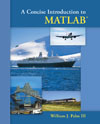 |  A Concise Introduction to MATLAB William J Palm III,
University of Rhode Island
Book Preface| PREFACE
Formerly used mainly by specialists in signal processing and numerical analysis, MATLAB® in recent years has achieved widespread and enthusi¬astic acceptance throughout the engineering, mathematics, and scientific communities. Many schools now require a course based entirely or in part on MATLAB early in the curriculum. MATLAB is programmable and has the same logical, relational, conditional, and loop structures as other programming languages, such as Fortran, C, BASIC, and Pascal. Thus it can be used to teach programming principles. In most schools a MATLAB course has replaced the traditional Fortran course, and MATLAB is the principal computational tool used throughout the curriculum.
The popularity of MATLAB is partly due to its long history, and thus it is well developed and well tested. People trust its answers. Its popularity is also due to its user interface, which provides an easy-to-use interactive environment that includes extensive numerical computation and visualization capabilities. Its compactness is a big advantage. For example, you can solve a set of many linear algebraic equations with just three lines of code, a feat that is impossible with traditional programming languages. MATLAB is also extensible; currently more than 20 “toolboxes” in vari¬ous application areas can be used with MATLAB to add new commands and capabilities.
MATLAB is available for MS Windows and Macintosh personal computers and for other operating systems. It is compatible across all these platforms, which enables users to share their programs, insights, and ideas. This text is based on MATLAB Version 7.4 (R 2007a). Some of the material in Chapter 7 is based on the Control System Toolbox, Version 8.0. Chapter 8 is based on Version 3.2 of the Symbolic Math Toolbox.
TEXT ORGANIZATION
The text consists of eight chapters. The first chapter gives an overview of MATLAB features, including its windows and menu structures. Chapter 2 introduces the concept of an array, which is the fundamental data element in MATLAB, and describes how to use numeric arrays, cell arrays, and structure arrays for basic mathematical operations. Chapter 2 also covers the solution of linear algebraic equations, which arise in many applications. Chapter 3 discusses the use of functions and files. MATLAB has an extensive number of built-in math functions, and users can define their own functions and save them as a file for reuse. Chapter 4 shows how to create decision-making programs with MATLAB, and it covers relational and logical operators, conditional statements, for and while loops, and the switch structure.
Chapter 5 treats two-dimensional plots in greater detail, as well as three-dimensional plots. Function discovery, which uses data plots to discover a mathematical description of the data, is a common application of plotting, and a separate section is devoted to this topic. The chapter also treats polynomial and multiple linear regression as part of its modeling coverage.
Chapter 6 reviews basic statistics and probability and shows how to use
MATLAB to generate histograms, perform calculations with the normal distribution, and create random number simulations. The chapter concludes with linear and cubic-spline interpolation.
Chapter 7 covers numerical methods for calculus and differential equations. Numerical integration and differentiation methods are treated. Ordinary differential equation solvers in the core MATLAB program are covered, as well as the linear-system solvers in the Control System toolbox.
Chapter 8 covers symbolic methods for manipulating algebraic expressions and for solving algebraic and transcendental equations, calculus, differential equations, and matrix algebra problems. The calculus applications include integration and differentiation, optimization, Taylor series, series evaluation, and limits. Laplace transform methods for solving differential equations are also introduced. This chapter requires the use of the Symbolic Math toolbox or the Student Edition of MATLAB.
Appendix A contains a guide to the commands and functions introduced in the text. Appendix B is a list of references. Answers to selected problems and a three-part index appear at the end of the text.
All figures, tables, equations, and exercises have been numbered according to their chapter and section. For example, Figure 3.4–2 is the second figure in Chapter 3, Section 4. This system is designed to help the reader locate these items. The end-of-chapter problems are the exception to this numbering system. They are numbered 1, 2, 3, and so on to avoid confusion with the in-chapter exercises. The problems are grouped according to the relevant chapter section.
The first four chapters constitute a course in the essentials of MATLAB. The remaining four chapters are independent of each other, and may be covered in any order, or may be omitted if necessary. These chapters provide additional coverage and examples of plotting and model building, probability and statistics, calculus and differential equations, and symbolic processing, respectively.
|
|



 2008 McGraw-Hill Higher Education
2008 McGraw-Hill Higher Education

 2008 McGraw-Hill Higher Education
2008 McGraw-Hill Higher Education